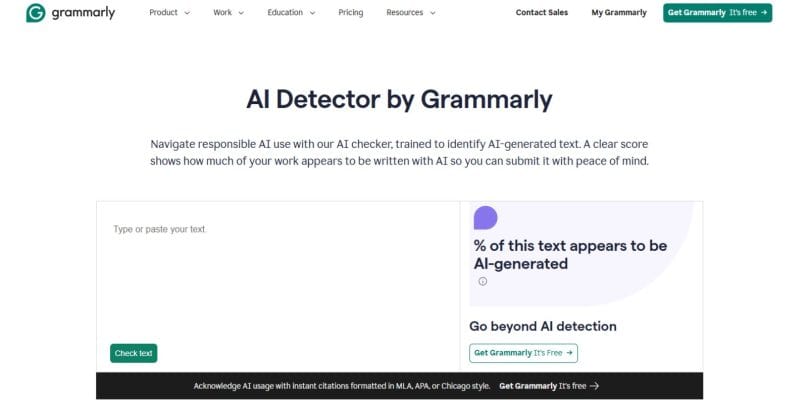Grammarly is a well-known AI-powered writing assistant used for grammar checking, spelling corrections, and style improvements. Recently, Grammarly introduced an AI detection feature to help users determine whether a piece of text was generated by AI. However, many users question the accuracy and reliability of Grammarly’s AI detection capabilities.
The short answer is no—Grammarly is not highly accurate for detecting AI-generated text. Unlike dedicated AI detection tools that analyze deep linguistic patterns, Grammarly’s AI detection often produces false positives or fails to identify AI-written content correctly. In this article, we’ll explore how Grammarly’s AI detection works, its accuracy, and better alternatives for detecting AI-generated content.
How Grammarly’s AI Detection Works

Grammarly’s AI detection relies on pattern recognition and language analysis to evaluate text. Instead of using deep probabilistic modeling or neural network analysis like advanced AI detectors, it identifies surface-level patterns that may suggest AI involvement.
One of the main ways Grammarly detects AI-generated content is by analyzing predictability in sentence structures. AI-generated text often follows a highly structured format, which can make it seem unnaturally uniform. Grammarly flags mechanically structured sentences that lack natural variation in tone, rhythm, and style, which are characteristics of human writing.
Another aspect Grammarly evaluates is repetitive phrasing and unnatural wording. AI-generated text sometimes overuses certain words or phrases, as language models predict words based on statistical probabilities rather than human creativity. Grammarly attempts to detect excessive repetition, awkward phrasing, and word choices that seem overly mechanical or unnatural.
In addition, Grammarly considers token probability—how AI models generate words and construct sentences based on likelihood rather than intention. AI-generated content often lacks spontaneity and follows a highly calculated pattern. Grammarly tries to recognize when writing feels overly predictable, which could suggest that it was produced by an AI model.
Despite these efforts, Grammarly’s AI detection is limited. It lacks deep linguistic analysis, sentence variation tracking, and advanced probability modeling, making it far less effective than dedicated AI detection tools.
How Accurate Is Grammarly’s AI Detection?
Grammarly’s AI detection has significant limitations, making it less reliable than specialized AI detectors. Here’s why:
- Limited AI detection capabilities – Grammarly’s focus is on writing improvement, not advanced AI detection.
- False positives – Grammarly may wrongly flag human-written content as AI-generated, leading to misleading results.
- Misses AI-written content – Well-edited AI-generated text often passes undetected by Grammarly.
- Lacks deep probability analysis – AI detection tools use statistical modeling and neural network analysis, which Grammarly does not.
For serious AI detection needs, Grammarly should not be the sole tool relied upon.
Grammarly vs. Dedicated AI Detection Tools
To better understand Grammarly’s AI detection accuracy, let’s compare it with specialized AI detectors:
| Feature | Grammarly AI Detection | Dedicated AI Detectors (GPTZero, Originality.ai) |
|---|---|---|
| AI Detection Accuracy | Low | High |
| False Positives | Frequent | Moderate |
| False Negatives | Common | Rare |
| Plagiarism Checking | Yes | Some tools include it |
| Best Use Case | Grammar & readability | AI detection & content verification |
Dedicated AI detection tools outperform Grammarly, making them better choices for identifying AI-generated text.
Can Grammarly Reliably Identify AI-Generated Content?
The short answer is no. Grammarly’s AI detection feature is not sophisticated enough to accurately differentiate between human-written and AI-generated content. While it may catch some basic AI writing patterns, it frequently misidentifies human text as AI-generated and fails to detect well-edited AI content.
This makes Grammarly unreliable for serious AI detection needs, particularly in academic, professional, and publishing settings, where false positives or false negatives can lead to problems. If accuracy is important, it is better to use specialized AI detection tools rather than relying on Grammarly.
Best Alternatives to Grammarly for AI Detection
Since Grammarly’s AI detection is unreliable, using dedicated AI detection tools is the best way to verify whether content was AI-generated. Some of the most accurate AI detection tools available today include:
- GPTZero – One of the most well-known AI detectors, designed specifically to identify text written by GPT-based models.
- Originality.ai – Used by publishers, educators, and businesses to check for AI-generated content.
- Turnitin AI Detection – Commonly used in academic settings to detect AI-assisted writing.
- Hugging Face AI Detection Tools – Open-source AI analysis tools that provide detailed linguistic breakdowns of text.
These tools are far more advanced than Grammarly’s AI detection and should be used for accurate AI identification.
Future of AI Detection: Will Grammarly Improve?
Grammarly may enhance its AI detection capabilities in the future, but currently, it lags behind dedicated AI detection tools. As AI-generated writing becomes more sophisticated, Grammarly would need to integrate more advanced natural language processing (NLP), probability-based AI models, and deeper contextual analysis to keep up.
Future AI detection systems may rely on multi-layered approaches that combine statistical modeling, deep-learning techniques, and pattern tracking. However, until Grammarly significantly improves its detection algorithms, it remains unsuitable for reliably identifying AI-generated content.
Conclusion: Is Grammarly Accurate for Detecting AI?
No, Grammarly is not highly accurate for AI detection. While it offers an AI detection feature, it frequently produces false positives and often misses AI-generated text. Grammarly remains best suited for grammar checking, spelling correction, and readability improvement, rather than AI content verification.
If you need reliable AI detection, tools like GPTZero, Originality.ai, and Turnitin AI Detection provide more accurate and trustworthy results. Always use multiple AI detection methods for verification, rather than relying solely on Grammarly’s AI detection.